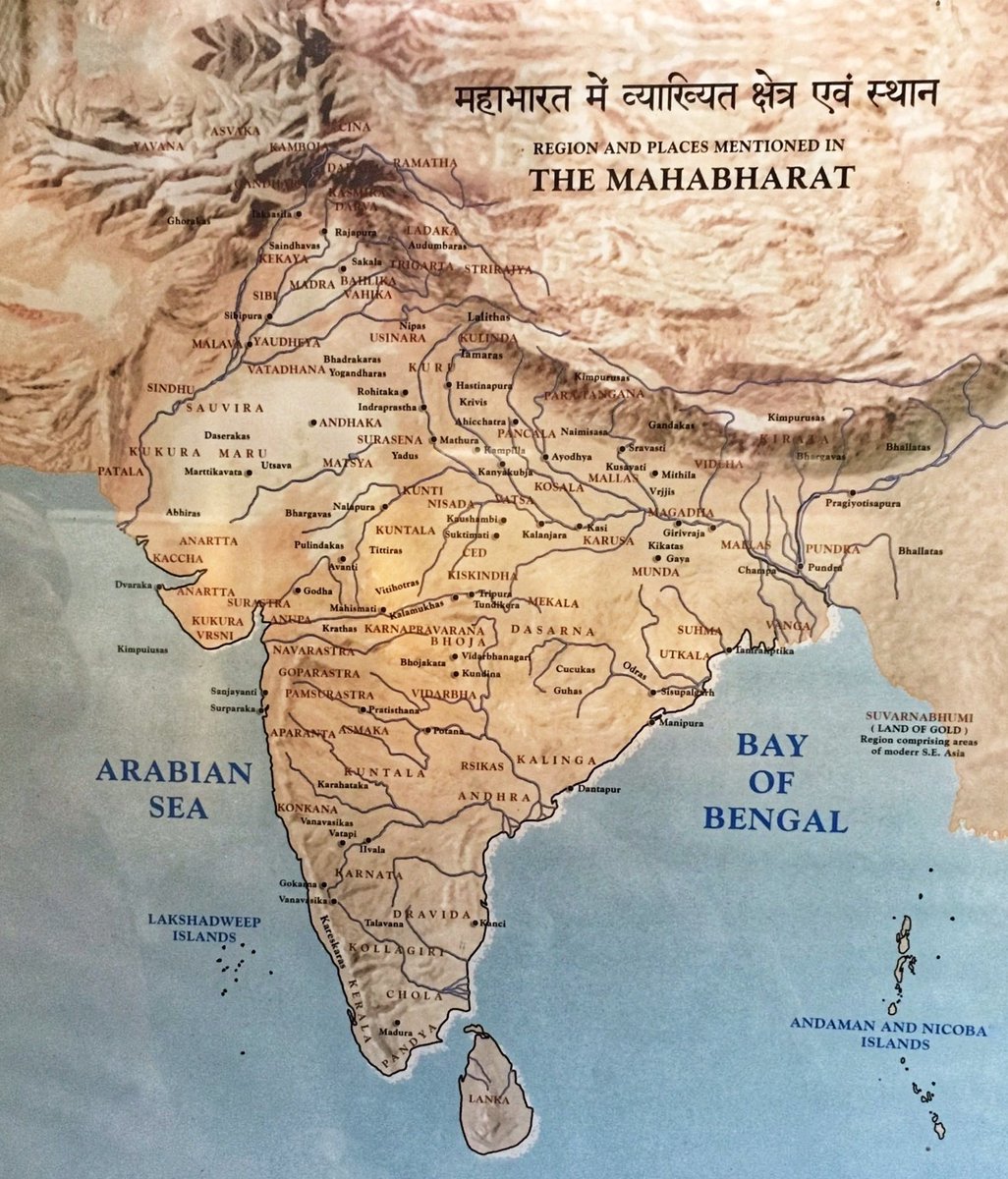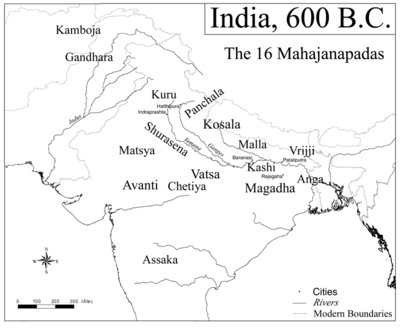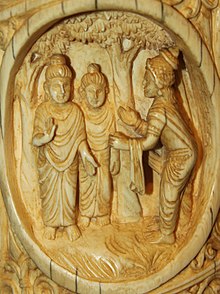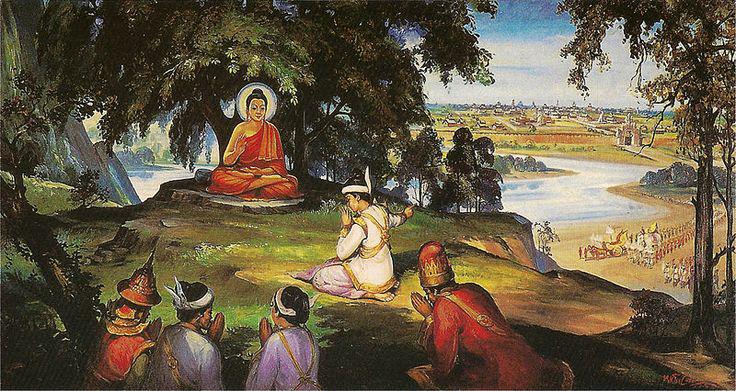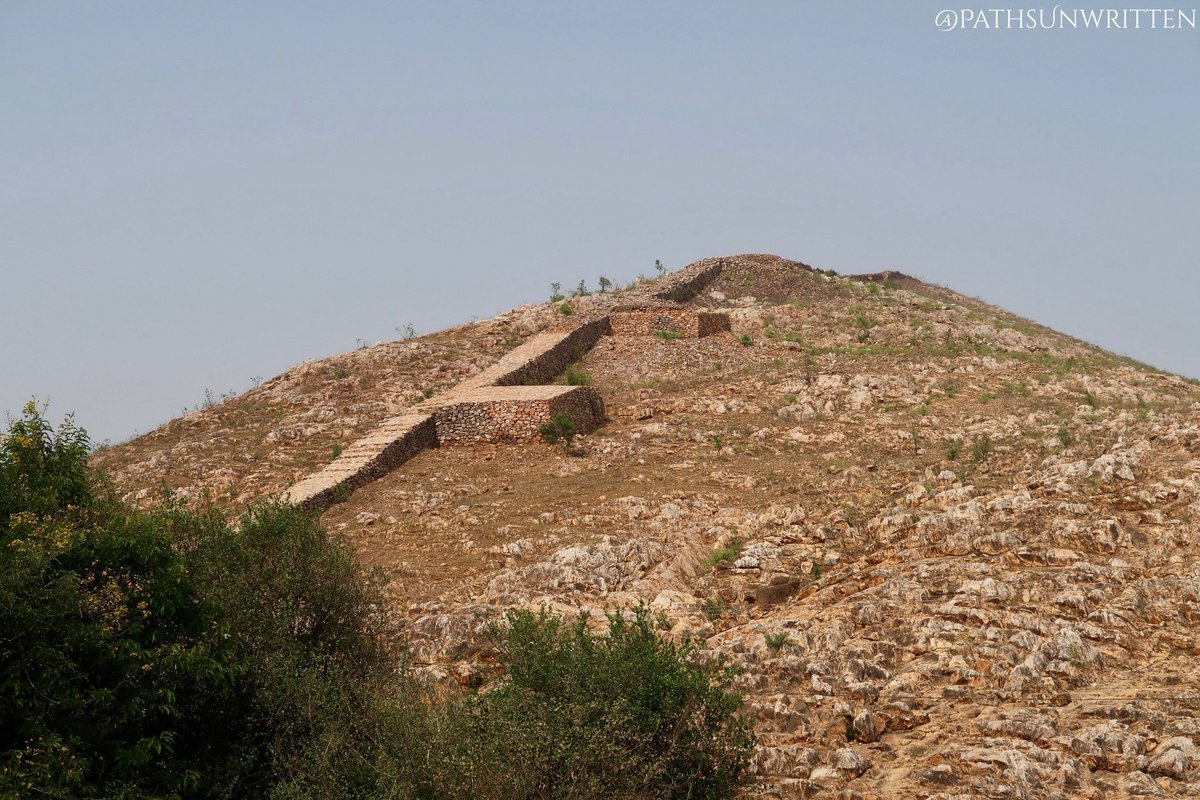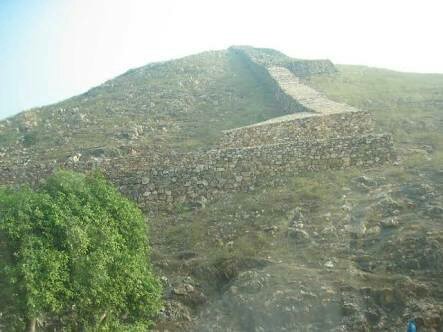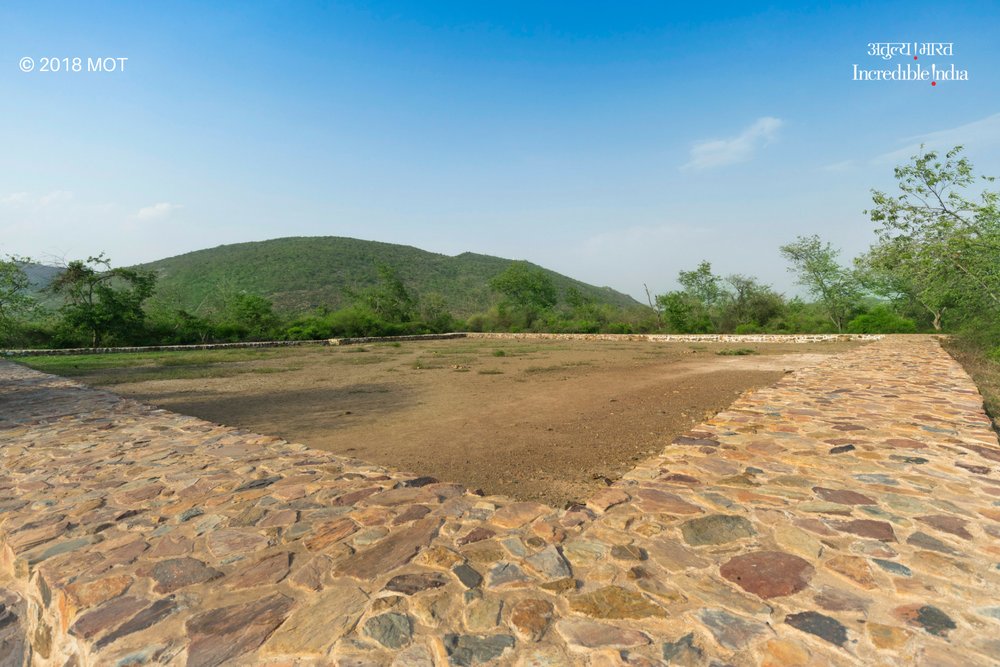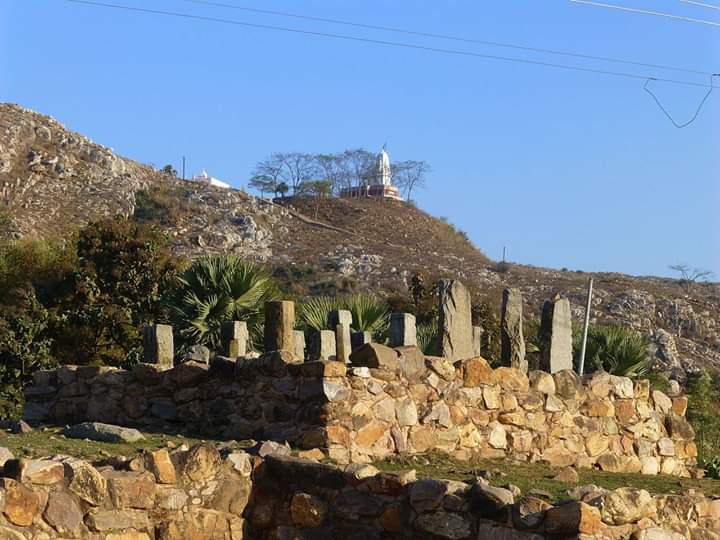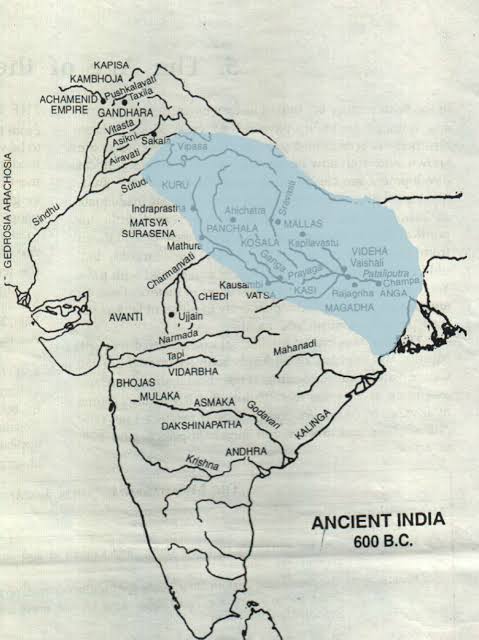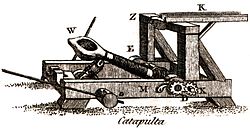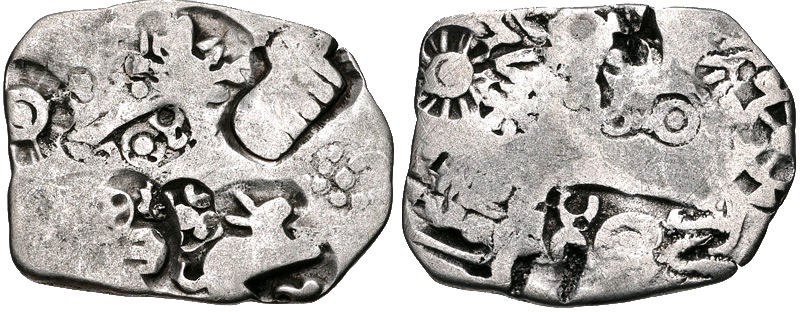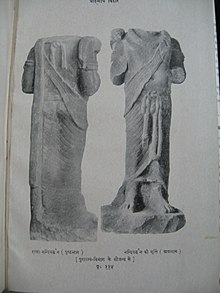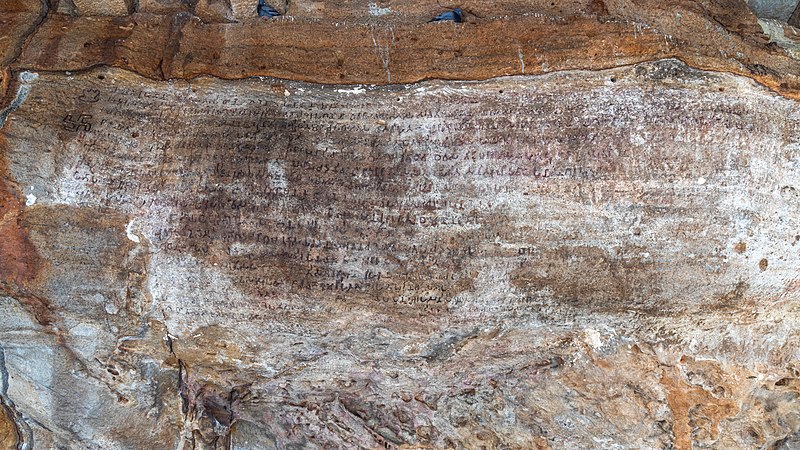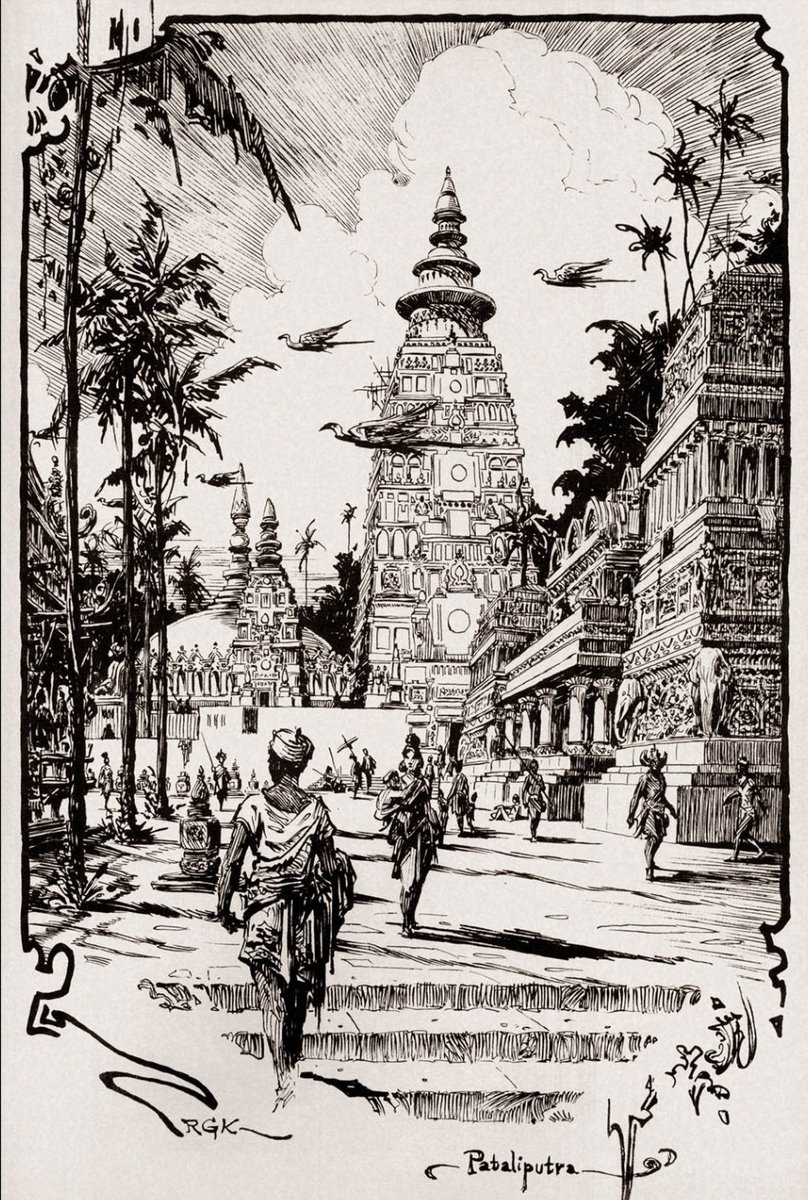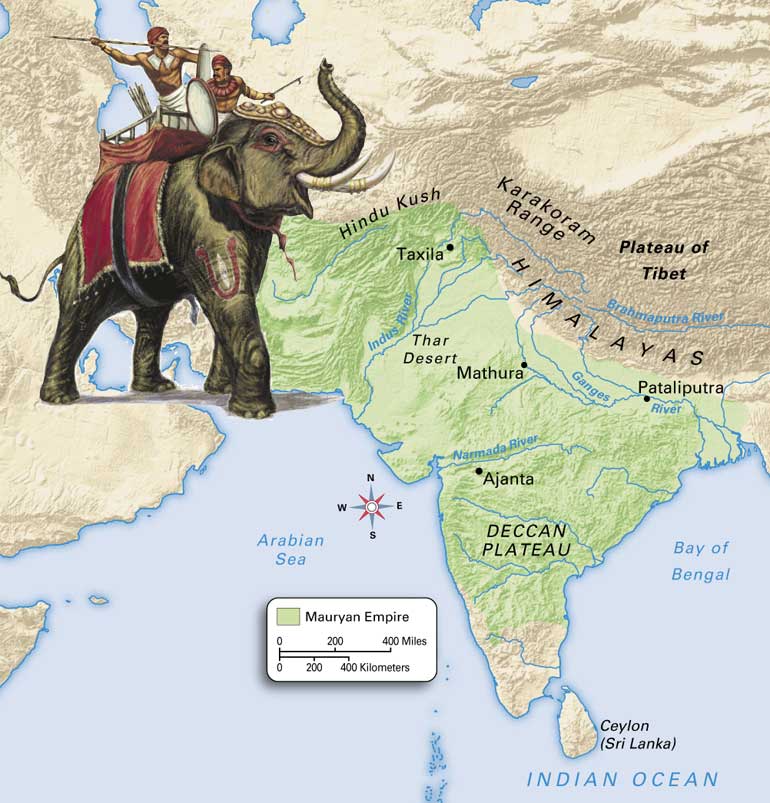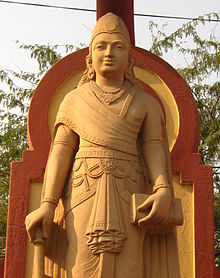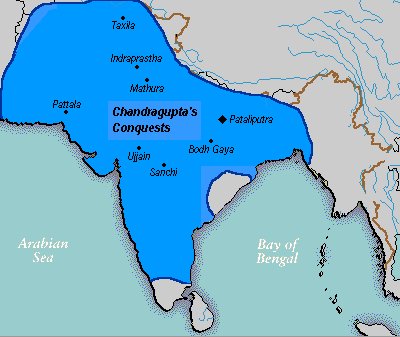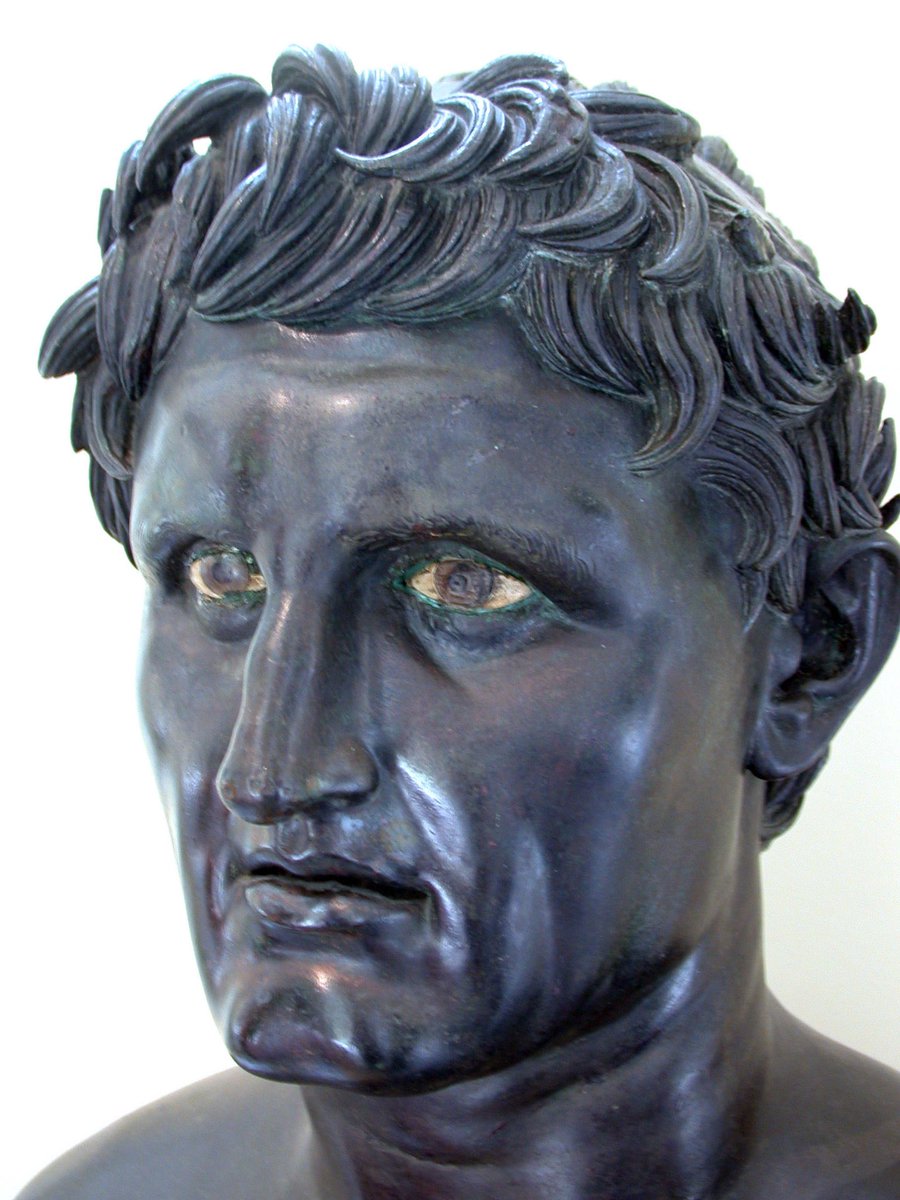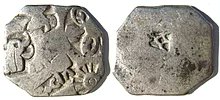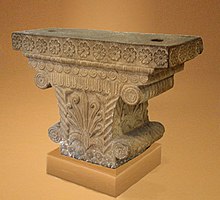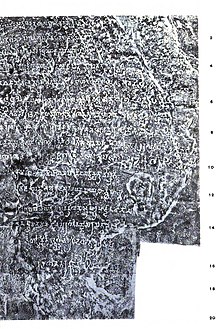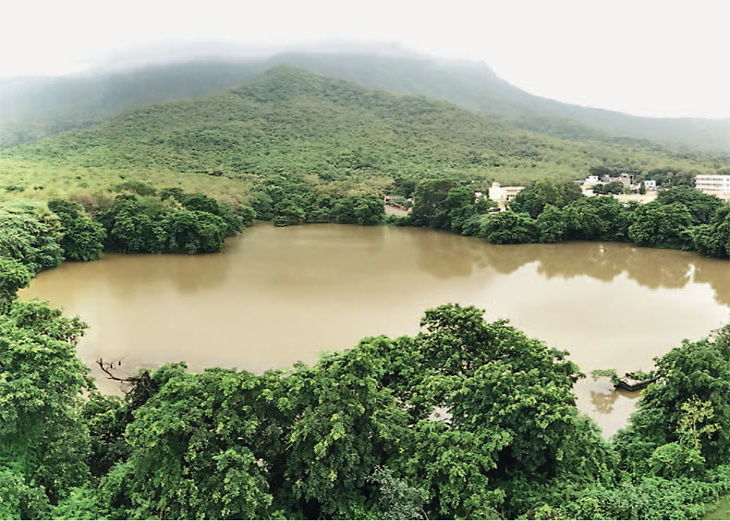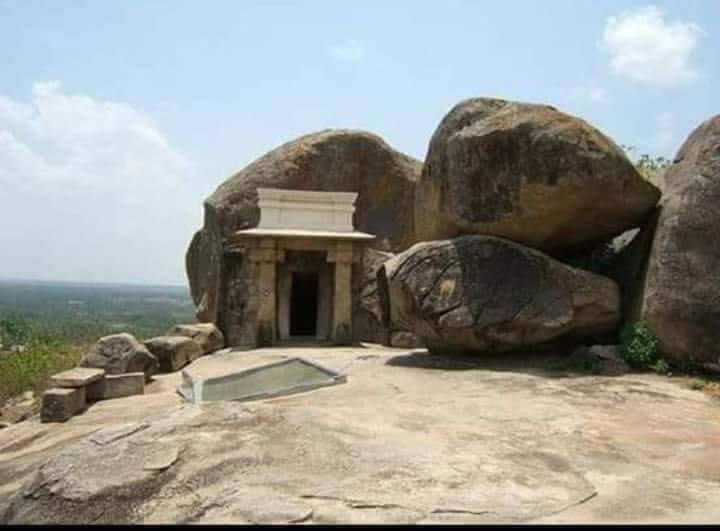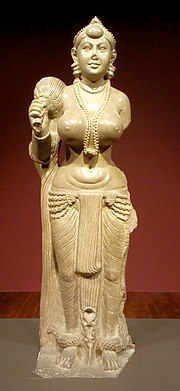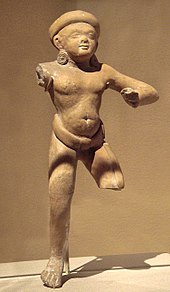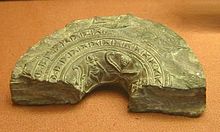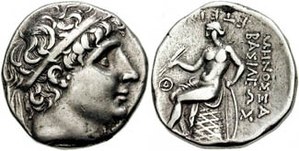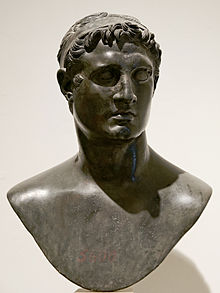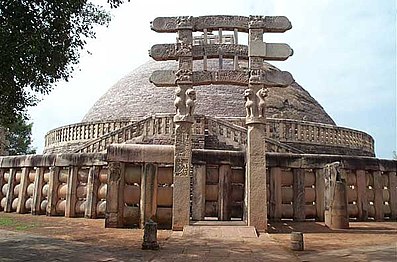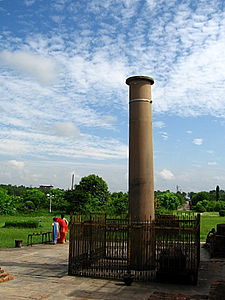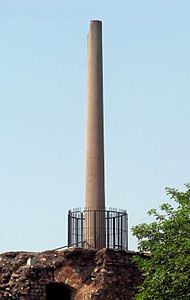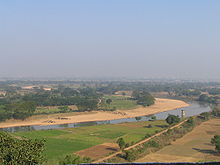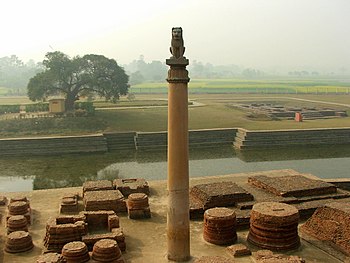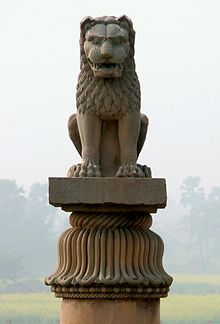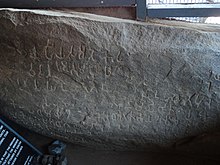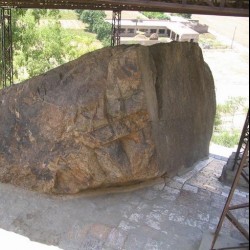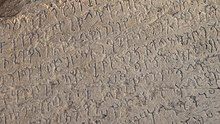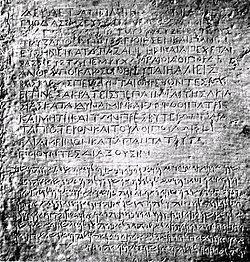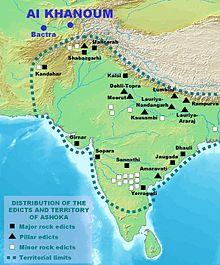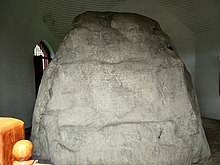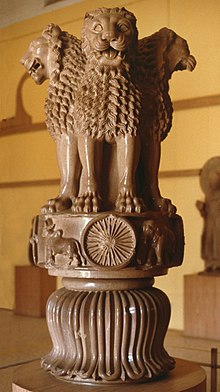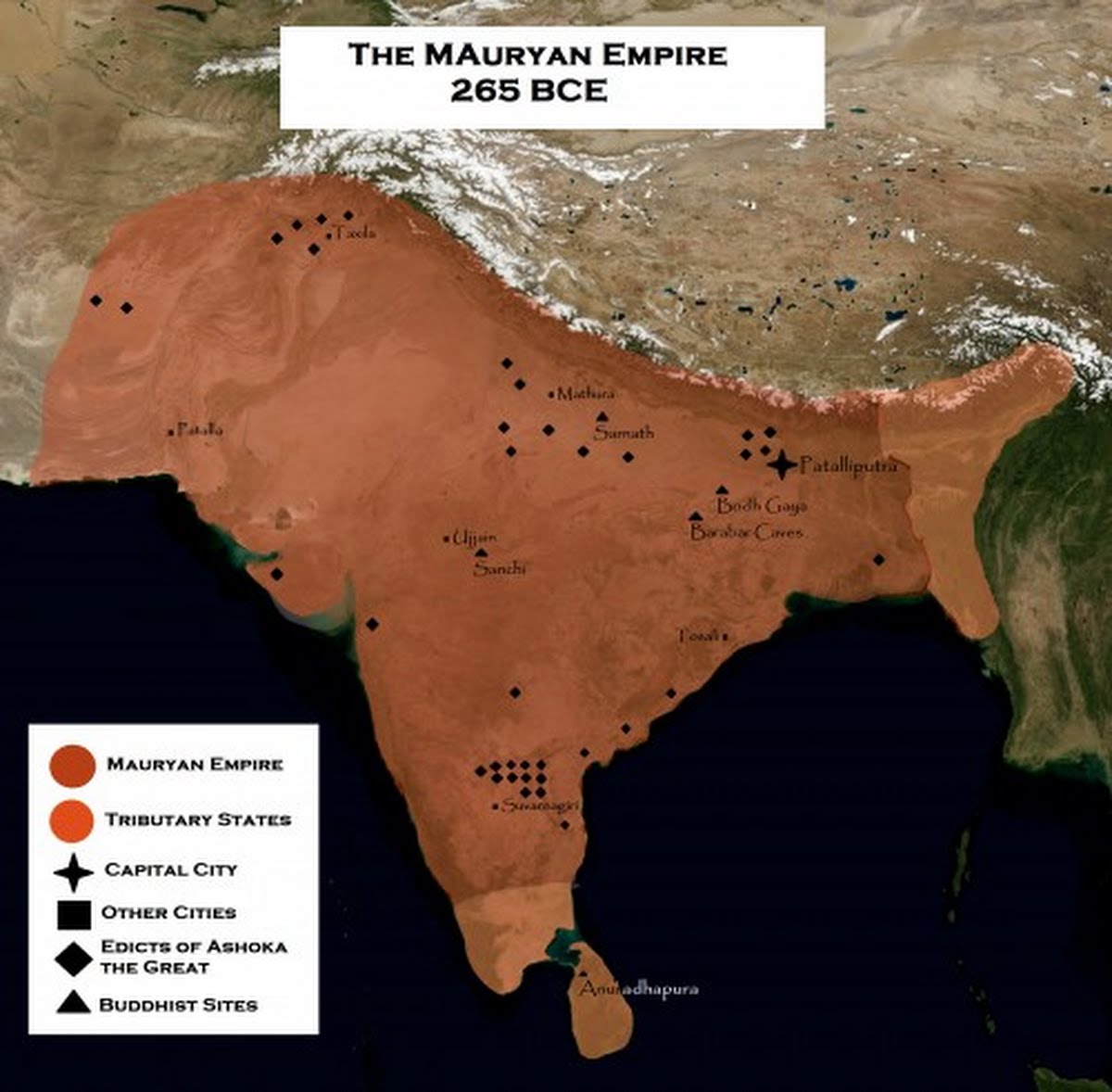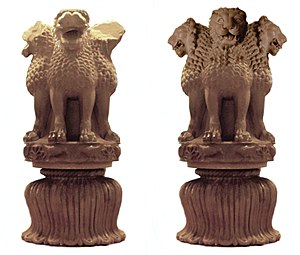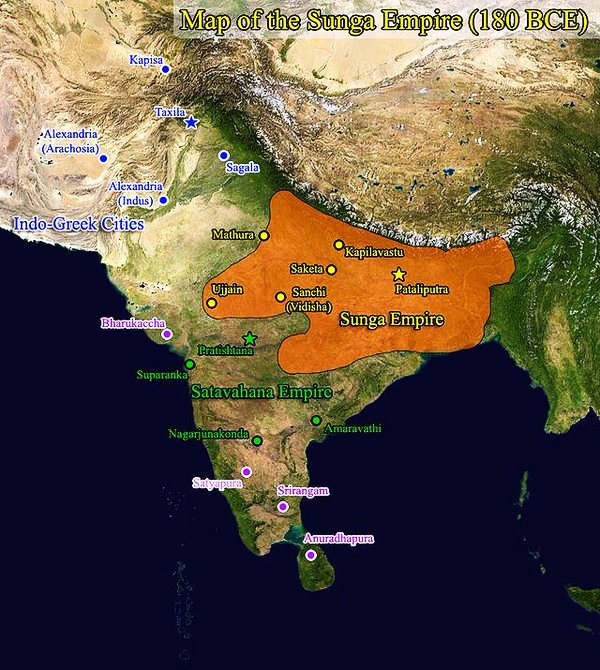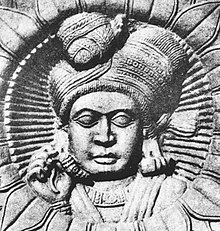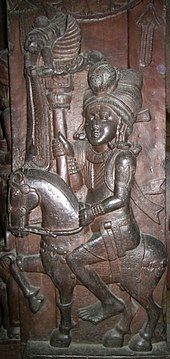Chapter 9 : Empires of India
This chapter will reflect on Indian Empires, in brief, from 6th Century BCE to 7th Century AD.
This chapter will reflect on Indian Empires, in brief, from 6th Century BCE to 7th Century AD.
1. Magadha Empires
a) Haryanka Dynasty
Magadha was ruled by the descendants of Jarasandha, hundreds of years after Kurukshetra, with its capital at Girivraja ( Rajgir).
The last king of this dynasty named Vipunjaya was assassinated by his own minister Sunipa.
a) Haryanka Dynasty
Magadha was ruled by the descendants of Jarasandha, hundreds of years after Kurukshetra, with its capital at Girivraja ( Rajgir).
The last king of this dynasty named Vipunjaya was assassinated by his own minister Sunipa.
Sunipa& #39;s son Pradyota became the king and started Pradyota dynasty in around 780 BCE.
After 138 years of rule of Pradyota dynasty, the reigns of Magadha was taken over by Sisunaga, who started the Haryana dynasty in around 642 BCE.
After 138 years of rule of Pradyota dynasty, the reigns of Magadha was taken over by Sisunaga, who started the Haryana dynasty in around 642 BCE.
Magadha came under the limelight when Bimbisara ( 542-491 BCE), took the throne in 542 BCE, then only 16 years old.
It was under Bimbisara that Magadha came into prominence.
It was under Bimbisara that Magadha came into prominence.
He annexed Anga ( Bengal), Avanti, conducted marriage alliances with Kingdoms of Kashi and Madra, met Gautama Buddha and is a respected figure in Jain documents.
Image of probable extent of Magadha under Bimbisara.
Image of probable extent of Magadha under Bimbisara.
He was a friend of Gautam Buddha and constructed monestary for the stay of the Buddha.
He was also the father of Vimala Kodana, from Amrapali of Vaishali.
Images of Buddha meeting Bimbisara
He was also the father of Vimala Kodana, from Amrapali of Vaishali.
Images of Buddha meeting Bimbisara
He reconstructed the capital city of Rajgriha with the help of his architect Pandit Mahagovinda and constructed cyclopean walls for its protection.
Images of the Cyclopean wall constructed by Bimbisara in the 6th Century BCE.
Images of the Cyclopean wall constructed by Bimbisara in the 6th Century BCE.
His son Ajatshatru impatient for the throne, imprisoned Bimbisara. Bimbisara later died in the jail.
Buddhist sources indicate that Ajatshatru killed his father and became the king.
Buddhist sources indicate that Ajatshatru killed his father and became the king.
Image of a excavated building at Rajgir called & #39; Bimbisara Jail& #39;.
While excavating this place in the 19th century, Archeologists found skeleton of a man in fetters inside this compound. Hence called & #39;Bimbisara Jail& #39;, after the legend.
While excavating this place in the 19th century, Archeologists found skeleton of a man in fetters inside this compound. Hence called & #39;Bimbisara Jail& #39;, after the legend.
Ajatshatru:
Son of Kosala Devi and Bimbisara, probably assassinated his father, if one believes the pali texts.
Image of fort of Ajatshatru at Rajgir, Bihar.
Son of Kosala Devi and Bimbisara, probably assassinated his father, if one believes the pali texts.
Image of fort of Ajatshatru at Rajgir, Bihar.
Texts suggests he fought a 16 year war with Licchavis and carried the might of Magadha arms up to Satluj river.
Image of a probable extent of Magadha empire under Ajatshatru
Image of a probable extent of Magadha empire under Ajatshatru
He made important improvements in warfare and constructed special catapults and scythed chariots to bring down his enemies.
A reconstructed image of Catapults and Scythed Chariots used by Ajatshatru.
A reconstructed image of Catapults and Scythed Chariots used by Ajatshatru.
Ajatshatru is the founder of Ancient city of Pataliputra ( modern Patna).
He founded the city in circa 488 BCE by building a fort under his ministers Vassakara and Sunita.
Image of Ajatshatru on an Elephant
He founded the city in circa 488 BCE by building a fort under his ministers Vassakara and Sunita.
Image of Ajatshatru on an Elephant
Under Ajatshatru, the first Buddhist Council was held after the death of Buddha in 483 BCE.
Ajatshatru was assassinated by his own son Udayan or Udaybhadra in 461 BCE, after ruling for 30 years.
Ajatshatru was assassinated by his own son Udayan or Udaybhadra in 461 BCE, after ruling for 30 years.
The successor of Ajatshatru named Udayan ( 461-445 BCE) shifted the capital from Rajgir to Pataliputra.
He ruled for 16 years and was assassinated by his son Anirudha or Nandivardhana.
An image of King Udyan of Magadha.
He ruled for 16 years and was assassinated by his son Anirudha or Nandivardhana.
An image of King Udyan of Magadha.
Buddhist texts mention that all successors of Bimbisara killed their own fathers to gain the kingdom.
Bimbisara was killed by Ajatshatru, the same thing befell Ajatshatru and his successors.
Bimbisara was killed by Ajatshatru, the same thing befell Ajatshatru and his successors.
People of Magadha rose in revolt against this type of behaviour and replaced the last ruler of Haryanka dynasty with his minister named Sisunaga.
Sisunaga started a dynasty after his own name in 413 BCE.
Sisunaga started a dynasty after his own name in 413 BCE.
b) Sisunaga Dynasty ( 413-387/382 BCE)
Sisunaga, a minister of last ruler of Haryanka dynasty became the ruler circa 413 BCE. He had twin capitals at Pataliputra and at Vaishali.
Conquered Avanti and made it a part of Magadha empire.
Image of coins of Magadha, 5th Century BCE
Sisunaga, a minister of last ruler of Haryanka dynasty became the ruler circa 413 BCE. He had twin capitals at Pataliputra and at Vaishali.
Conquered Avanti and made it a part of Magadha empire.
Image of coins of Magadha, 5th Century BCE
The son of Sisunaga, named as Kakarvani Kalasoka in Sri Lankan texts, precided over the second Buddhist council.
He and his nine sons were killed by Mahapadma Nanda in around 387 or 382 BCE, who then started the Nanda dynasty of Magadha
Image of a Magadha king.
He and his nine sons were killed by Mahapadma Nanda in around 387 or 382 BCE, who then started the Nanda dynasty of Magadha
Image of a Magadha king.
c) Nanda Dynasty :
The dynasty was founded by Mahapadma Nanda or Ugrasena Nanda, as described in the pali texts.
Puranas give him a reign of 88 years. Modern historians think that Nanda dynasty started in 387/382/364, or 345 BCE.
The dynasty was founded by Mahapadma Nanda or Ugrasena Nanda, as described in the pali texts.
Puranas give him a reign of 88 years. Modern historians think that Nanda dynasty started in 387/382/364, or 345 BCE.
Mahapadma Nanda ( 387/382 - 350 BCE ?)
The first ruler of Nanda dynasty. Information about him can be found in Puranas, jain texts and Buddhist texts.
He has also been described by Greek historians and by Banabhatta in Harshcharitra.
Coin of Magadha, 4th Century BCE
The first ruler of Nanda dynasty. Information about him can be found in Puranas, jain texts and Buddhist texts.
He has also been described by Greek historians and by Banabhatta in Harshcharitra.
Coin of Magadha, 4th Century BCE
Mahapadma Nanda was possibly a barber by profession.
The Puranas call the kings of Nanda dynasty as Sudras, the Buddhist texts call Nandas as & #39; Chorapubas& #39; ( dacoits of the old).
The Puranas call the kings of Nanda dynasty as Sudras, the Buddhist texts call Nandas as & #39; Chorapubas& #39; ( dacoits of the old).
Curtius Rufus ( 1st Century AD) says that Poros informed Alexander that:
" the present king ( Dhana-Nanda, a successor of Mahapadma) was not merely a man originally of no distinction, but even of the very meanest condition."
" the present king ( Dhana-Nanda, a successor of Mahapadma) was not merely a man originally of no distinction, but even of the very meanest condition."
Curtis continues: " His father ( Mahapadma) was in fact a barber who stealthy became the Queen& #39;s paramour & encompassed the assassination of the king by treachery.
Then under the pretence of acting as a guardian to the royal children, he usurped the kingship,
Then under the pretence of acting as a guardian to the royal children, he usurped the kingship,
and having put the young princes ( 9 sons of Kakarvani Sisunaga) to death, begot the present king who was detested and held cheap by his subjects."
Banabhatta& #39;s Harshcharitra records the story that King Kakarvani Sisunaga was killed by a & #39; dagger thurst into his throat in the neighborhood of his city& #39; ( Pataliputra).
Thus, a barber became a King of Magadha.
Thus, a barber became a King of Magadha.
Mahapadma or the & #39; lord of infinite host& #39; created a large empire under his rule. It extended as far as Satluj river in the Punjab.
Mahapadma Nanda by his conquests became a & #39; second Parshurama& #39; and destroyed Kshatriya kingdoms across the country.
Mahapadma Nanda by his conquests became a & #39; second Parshurama& #39; and destroyed Kshatriya kingdoms across the country.
The kingdoms of Aikshvakus, Panchala, Kashi, Haihyas, Kalinga, Asmakas, Kurus, Maitilas, Surasenas and Vitthoras were completely " uprooted ", as Puranas tell us.
Towards the south Mahapadma extended his sovereignty by the conquest of Kalinga.
Towards the south Mahapadma extended his sovereignty by the conquest of Kalinga.
The Hathigumpha inscription of Kharavela mentions & #39; Nanda Raja& #39; as being associated with an old aqueduct, & as having carried away to Magadha, as trophies the statue of first Jina (probably the first teerthankara of jains), along with treasures.
Image of Hathigumpha inscription
Image of Hathigumpha inscription
Dhana-Nanda ( 350 ? - 322 BCE)
Called Agrames or Xandrames by Greek historians.
Had a wealth amounting to 80 kotis ( 800 million or 80 crore), plus 990 million gold pieces.
All this wealth, he had acquired by levying taxes on wood, gums, tree, stones, etc.
Called Agrames or Xandrames by Greek historians.
Had a wealth amounting to 80 kotis ( 800 million or 80 crore), plus 990 million gold pieces.
All this wealth, he had acquired by levying taxes on wood, gums, tree, stones, etc.
He was called Dhana-Nanda by contempt as he was fond of hoarding treasure.
The form Agrames is modified into Xandramas by Diodorus
F.W Thomas takes it to be equivalent of the name & #39; Chandramas& #39;. He takes Agrames as Dhana-Nanda to be his nick name & Chandramas as a personal one.
The form Agrames is modified into Xandramas by Diodorus
F.W Thomas takes it to be equivalent of the name & #39; Chandramas& #39;. He takes Agrames as Dhana-Nanda to be his nick name & Chandramas as a personal one.
The Empire under Dhana-Nanda possessed immense power and resources.
Curtius Rufus estimates its military strength at 200,000 infantry, 20,000 cavalry, 2,000 four-horsed chariots and 3,000 War-Elephants.
Curtius Rufus estimates its military strength at 200,000 infantry, 20,000 cavalry, 2,000 four-horsed chariots and 3,000 War-Elephants.
Its just possible that these figures may have reached the ears of soldiers of Alexander, as they refused their king& #39;s orders to march further and instead revolted.
Alexander stopped his conquests at Beas river and went back via Gedrosian desert. Thousands died in his retreat.
Alexander stopped his conquests at Beas river and went back via Gedrosian desert. Thousands died in his retreat.
Dhana-Nanda was the last sovereign of the Nanda dynasty. His kingdom was taken away by Chanakya & Chandragupta Maurya.
Jain texts mention that Dhana-Nanda was allowed to leave his capital in two chariots, with as much baggage he could take away.
Jain texts mention that Dhana-Nanda was allowed to leave his capital in two chariots, with as much baggage he could take away.
Buddhist texts mention him as being killed.
The 7th century play & #39; Mudra-rakshsa ( signet ring of Rakshsa), mentioned him as being killed by Chanakya & Chandragupta, along with his nine brothers.
Chandragupta started the Mauryan Empire in 322 BCE.
The 7th century play & #39; Mudra-rakshsa ( signet ring of Rakshsa), mentioned him as being killed by Chanakya & Chandragupta, along with his nine brothers.
Chandragupta started the Mauryan Empire in 322 BCE.
Let& #39;s pause for a moment and reflect on what made Magadha a supreme power of India for a long time starting 6th century BCE.
The answer is very simple. The reasons for Magadhan dominance can be attributed to three things.
These are as under:
The answer is very simple. The reasons for Magadhan dominance can be attributed to three things.
These are as under:
1) Trade Routes: We know that Uttarpatha was a major trading route of those days, where caravans of neighbouring kingdoms used to travel.
The geographical location of Magadhan cities like Pataliputra, Vaishali, Rajagriha made it an important destination of trade caravans.
The geographical location of Magadhan cities like Pataliputra, Vaishali, Rajagriha made it an important destination of trade caravans.
In addition, the trade routes of water-ways and rivers also made Magadha as a top destination for trade.
2) Iron : It is very well known that Magadha, ( presently the area of Chota Nagpur, Jharkhand) is very rich in minerals.
Their were plenty of ores in those times,
2) Iron : It is very well known that Magadha, ( presently the area of Chota Nagpur, Jharkhand) is very rich in minerals.
Their were plenty of ores in those times,
particularly of iron. The iron extracted from these ores were useful for the purpose of making weapons, and thus Magadhan army were equipped with latest arms and armaments made of iron or other metals.
Image of an ancient Indian city.
Image of an ancient Indian city.
3) Elephants: The uncleared jungles upon which a village could draw for fire-wood and litter, were also abode of wild beasts, particularly elephants.
These forests like Andhvana of Kosala, Sitvahana of Maghada, Veluvana at Rajgriha, or the Prachina Vamsadaya of Sakya country, were full of wild elephants , which could be trained and drafted into the army.
These elephants used to function like modern tanks in the battlefield and could win a victory on its own without support from any division of friendly army.
Thus, drafting of these War-Elephants into the fold increased Magadhan superiority over other states of the time.
Thus, drafting of these War-Elephants into the fold increased Magadhan superiority over other states of the time.
2. Mauryan Empire ( 322 - 185 BCE)
The first empire of India, is the largest empire of India till date with 5 million sq km of area under them, equivalent to the Roman Empire at its height.
For the first time in recorded history, India was politically unified under one ruler.
The first empire of India, is the largest empire of India till date with 5 million sq km of area under them, equivalent to the Roman Empire at its height.
For the first time in recorded history, India was politically unified under one ruler.
Chandragupta Maurya
He is considered to be the greatest emperor of India. He also figures as the first & #39;historical& #39; emperor of India in the sense that he is the earliest emperor in Indian history whose historicity can be established on the solid ground of ascertained chronology.
He is considered to be the greatest emperor of India. He also figures as the first & #39;historical& #39; emperor of India in the sense that he is the earliest emperor in Indian history whose historicity can be established on the solid ground of ascertained chronology.
Chandragupta is the first of the rulers of India to be able to join up the valleys of Indus & the land of five rivers with the eastern valleys of Ganga and Yamuna in one empire that stretched from Aria ( Herat, in Afghanistan) to Bengal, and from Kashmir to Mysore.
Chandragupta with the help of his guru and author of Arthashastra, Chanakya was able to overthrow the & #39;irreligious& #39; and & #39;adharmik& #39; rule of Shudra Nanda Kings in 322 BCE.
He is known to Greek and Roman authors as Sandrocotus and Androcottus, respectively.
An image of Kautilya
He is known to Greek and Roman authors as Sandrocotus and Androcottus, respectively.
An image of Kautilya
In 305 BCE, one of the generals of Alexander - Seleukos Nicaktor crossed the Indus and invaded India.
Unlike, what Alexander had experienced, this time Seleukos came up against a unified India under Chandragupta and was defeated in this invasion.
An image of Seleukos
Unlike, what Alexander had experienced, this time Seleukos came up against a unified India under Chandragupta and was defeated in this invasion.
An image of Seleukos
Under the terms of treaty, Seleukos had to cede the provinces of :
1) Aria ( Herat) ;
2) Paropansidae ( Kabul Valley);
3) Archosia ( Kandahar, in Afghanistan); and
4) Gedrosia ( Balchustan)
To cement the friendship, Chandragupta gave a gift of 500 elephants to Seleukos.
1) Aria ( Herat) ;
2) Paropansidae ( Kabul Valley);
3) Archosia ( Kandahar, in Afghanistan); and
4) Gedrosia ( Balchustan)
To cement the friendship, Chandragupta gave a gift of 500 elephants to Seleukos.
As Appian puts it, there was also a "Jus Conubi" or & #39; intermarriage& #39; between Seleukos and Chandragupta.
Popular Indian legends describe Chandragupta as marrying an unnamed daughter of Seleukos.
Image of punch-marked coins of 4th Century BCE, possibly Mauryan.
Popular Indian legends describe Chandragupta as marrying an unnamed daughter of Seleukos.
Image of punch-marked coins of 4th Century BCE, possibly Mauryan.
Chandragupta had an immense army. According to Pliny, his army consisted of 6,00,000 infantry, 30,000 cavalry and 9,000 war -elephants.
According to Plutarch with this army " Androcottus overran the whole of India".
Image of Pataliputra Capital, at Patna Museum.
According to Plutarch with this army " Androcottus overran the whole of India".
Image of Pataliputra Capital, at Patna Museum.
Chandragupta is also the first of the Indian emperors to cross the Vindhayas and conquer South India till southern Karnataka and parts of Tamil Nadu.
Tamil poets speak of "Mauryan Chariots cutting through and brilliantly clad" invading the southern kingdoms.
Tamil poets speak of "Mauryan Chariots cutting through and brilliantly clad" invading the southern kingdoms.
He also constructed the Sudarshna lake, as described by rock inscription of Rudradaman at Junagarh ( 150 AD).
This artificial lake was able to provide for the local residents for the next 750 years.
Images of Junagarh inscription of Rudradaman and the Sudarshan lake.
This artificial lake was able to provide for the local residents for the next 750 years.
Images of Junagarh inscription of Rudradaman and the Sudarshan lake.
According to Jain traditions, Chandragupta abdicated, converted to Jain religion and emigrated south with his guru Bhadrabahu, where he committed & #39; Sallekhana& #39; and died after a few years.
Image of samadhi of Chandragupta Maurya at Srvana-Belagola, Karnataka.
Image of samadhi of Chandragupta Maurya at Srvana-Belagola, Karnataka.
It must be noted here that J.F. Fleet does not believe in these traditions and considers this Bhadrabahu as becoming a pontiff in 53 BCE.
His disciple Guptigupta succeeded him in 31 BCE. According to Fleet, this Guptigupta has been confused with Chandragupta.
His disciple Guptigupta succeeded him in 31 BCE. According to Fleet, this Guptigupta has been confused with Chandragupta.
Chandragupta Maurya ruled for 24 years between 322 - 298 BCE.
His wife is mentioned as Durdhara in Jain traditions. In Buddhist traditions, he married the daughter of his maternal uncle.
He had at least one son, named Bindusara who succeeded him in 298 BCE.
His wife is mentioned as Durdhara in Jain traditions. In Buddhist traditions, he married the daughter of his maternal uncle.
He had at least one son, named Bindusara who succeeded him in 298 BCE.
Bindusara ( 298 - 273 BCE)
Successor of Chandragupta was Bindusara.
He was able to maintain the vast empire created by his father.
He has been called & #39;Amityocates& #39; by the Greek historians.
Image of Yakshini figure of Mauryan age.
Successor of Chandragupta was Bindusara.
He was able to maintain the vast empire created by his father.
He has been called & #39;Amityocates& #39; by the Greek historians.
Image of Yakshini figure of Mauryan age.
Bindusara was not a pacifist like Ashoka. This is indicated by his very title & #39; Amitraghata& #39; (slayer of the foes) and this title may have been earned by him by some of his conquests.
A vague hint of these is given by the author of & #39; Arya Manjusri Mula-kalpa& #39;.
A vague hint of these is given by the author of & #39; Arya Manjusri Mula-kalpa& #39;.
Hemachandra & Taranath state that & #39; that apostle of violence, Chanakya had outlived Chandragupta and continued as a minister of Bindusara as one of his & #39;great lords& #39;.
Taranatha states: " Chanakya accomplished the destruction of the nobles and kings of 16 regions and made Bindusara master of all regions lying between the eastern and western seas."
It may have been possible that Bindusara quashed a rebellion as the south was already a part of Mauryan empire as this region was conquered by his illustrious father.
Image of a Mauryan statue.
Image of a Mauryan statue.
Bindusara& #39;s capacity as a conqueror remains in doubt.
During his lifetime, the NW province of Taxila revolted and he had to sent his son Ashoka from Ujjain to end the rebellion.
During his lifetime, the NW province of Taxila revolted and he had to sent his son Ashoka from Ujjain to end the rebellion.
It may be presumed that the mere maintenance of a vast empire which was bequeathed to him by his father was too a heavy burden for a man of easy going disposition whose delight in life was " figs and raisin wine" for which he depended on his friend, Antiochus of Syria.
Thus, Bindusara can hardly be credited with any additions to the Mauryan empire by his own conquests.
Friendly relations continued between India and the Greek kingdoms to the west during Bindusara& #39;s reign as an emperor.
Image of a Mauryan age ringstone
Friendly relations continued between India and the Greek kingdoms to the west during Bindusara& #39;s reign as an emperor.
Image of a Mauryan age ringstone
Antiochus- I sent his ambassador to Bindusara named as Daimachus of Plataea.
Pliny mentions Dionysius as the ambassador dispatched to India by Ptolemy Philadelphus ( king of Egypt, 285-247 BCE)
Images of Antiochus- I and Ptolemy Philadelphus respectively.
Pliny mentions Dionysius as the ambassador dispatched to India by Ptolemy Philadelphus ( king of Egypt, 285-247 BCE)
Images of Antiochus- I and Ptolemy Philadelphus respectively.
Patanjali mentions 500 ministers in Bindusara& #39;s cabinet.
Southern texts mentions Bindusara as the father of 101 sons & daughters from his 16 official wives.
Southern texts mentions Bindusara as the father of 101 sons & daughters from his 16 official wives.
Only the names of his three sons are known. His eldest son was Susima, Ashoka who succeeded him and Vitasoka, who was Ashoka& #39;s brother.
Bindusara died of illness in 273 BCE after a reign of 25 years and was succeed by his son Ashoka.
Bindusara died of illness in 273 BCE after a reign of 25 years and was succeed by his son Ashoka.
Ashoka Maurya ( 304 - 232 BCE, reigned 269-232 BCE)
Ashoka was the third emperor of the Mauryan empire and possibly is the most well known king of India throughout the world.
Image of Ashoka with his two wives and three attendants, from Sanchi.
Ashoka was the third emperor of the Mauryan empire and possibly is the most well known king of India throughout the world.
Image of Ashoka with his two wives and three attendants, from Sanchi.
Ashoka was born to Bindusara and his another wife named Dharma hi n 304 BCE.
He was 18 years old when he was sent to Ujjain as a Viceroy. After serving there, he was sent to Taxila to quell a revolt, which his elder brother Susima could not do.
Image of Sanchi Stupa
He was 18 years old when he was sent to Ujjain as a Viceroy. After serving there, he was sent to Taxila to quell a revolt, which his elder brother Susima could not do.
Image of Sanchi Stupa
Emperor Bindusara died in 273 BCE. Northern and southern texts agree that Ashoka had to fight for his throne as he was not the eldest among his brothers.
He was responsible for the deaths of at least 6 of his brothers if Tarnatha is anything to go by.
Asoka pillar at Lumbini.
He was responsible for the deaths of at least 6 of his brothers if Tarnatha is anything to go by.
Asoka pillar at Lumbini.
Ashoka& #39;s real reign began in 269 BCE.
The legends talking about Ashoka killing his 99 brothers are incorrect as he himself talks about the palaces and harems of his brothers in one of his Rock edicts, and wishes them well.
Image of Ashokan pillar at Firoz Shah Kotla, Delhi.
The legends talking about Ashoka killing his 99 brothers are incorrect as he himself talks about the palaces and harems of his brothers in one of his Rock edicts, and wishes them well.
Image of Ashokan pillar at Firoz Shah Kotla, Delhi.
The only political event of his reign was his campaign against Kalinga in year 8 of his reign, i.e, in 261 BCE.
The army of Kalinga as calculated by Megasthenes in 300 BCE was 50,000 infantry, 1,000 cavalry and 700 elephants strong.
Image of the battlefield of Kalinga.
The army of Kalinga as calculated by Megasthenes in 300 BCE was 50,000 infantry, 1,000 cavalry and 700 elephants strong.
Image of the battlefield of Kalinga.
By 261 BCE, this army must have increased substantially.
The battle of Kalinga was a massacre. It changed the whole imperial policy of annexation and aggression adopted by previous kings.
Image of Ashokan Pillar at Vaishali
The battle of Kalinga was a massacre. It changed the whole imperial policy of annexation and aggression adopted by previous kings.
Image of Ashokan Pillar at Vaishali
Ashoka informs in his Rock edict XIII that his own conquest was that of Kalinga & further that this conquest was the cause of much pain and repentance to him because it had been achieved by so much violence and bloodshed.
Image of Rock Edict XIII of Ashoka at Dhauli, Orissa.
Image of Rock Edict XIII of Ashoka at Dhauli, Orissa.
The battle of Kalinga resulted in " 150,000 captives ( apavadhe), 100,000 killed ( hateh) & many times that number dead from the wounds ( muteh)".
He felt so deeply his personal responsibility for this carnage that he at once declared for & #39; Dharma Vijaya& #39; and abolished wars.
He felt so deeply his personal responsibility for this carnage that he at once declared for & #39; Dharma Vijaya& #39; and abolished wars.
Hordes of people think that Ashoka converted to Buddhism after the battle of Kalinga.
However, by his own admission he was a & #39;upasaka& #39; or lay-follower or an ordinary convert to Buddhism at least 2.5 years before Kalinga.
Images of Maski Rock edict, 260 BCE and its translation.
However, by his own admission he was a & #39;upasaka& #39; or lay-follower or an ordinary convert to Buddhism at least 2.5 years before Kalinga.
Images of Maski Rock edict, 260 BCE and its translation.
Ashoka, however, did not inherit, but was a convert to Buddhism.
Like his predecessors, he freely allowed the slaughter of animals in royal kitchens every day, prior to conversion. In fact, Ashoka did not become an absolute vegetarian, even after his conversion.
Like his predecessors, he freely allowed the slaughter of animals in royal kitchens every day, prior to conversion. In fact, Ashoka did not become an absolute vegetarian, even after his conversion.
His meat diet was limited to the flesh of two deers and one peacock , even in 258 BCE; some six years after his conversion and though the deer was discarded later, it is not definitely known if the peacock was given up as well.
Image of the word & #39;Upasaka& #39; in Ashoka& #39;s minor RE I.
Image of the word & #39;Upasaka& #39; in Ashoka& #39;s minor RE I.
The list of animals and birds specified by Ashoka for protection in his Pillar Edict V, issued in 243 / 242 BCE does not include Peacock.
Similarly, he induldged in all kinds of royal parties and merry-making before his conversion.
( translation of a part of Pillar Edict V )
Similarly, he induldged in all kinds of royal parties and merry-making before his conversion.
( translation of a part of Pillar Edict V )
And he had been described in all texts as the one who killed his elder brother, Susima for the throne.
Lastly, even as a Buddhist, he did not desist from a bloody battle at Kalinga, some 2.5 years after his conversion to Buddhism.
This battle gave rise to 4 lac casualties.
Lastly, even as a Buddhist, he did not desist from a bloody battle at Kalinga, some 2.5 years after his conversion to Buddhism.
This battle gave rise to 4 lac casualties.
Thus, no stories such as those anxiously invented by the Buddhist texts are needed to prove the miraculous power of Buddhism in converting an ordinary king into a saint.
The facts speak for themselves. Buddhism had no particular effect on him, except his rule of not making war.
The facts speak for themselves. Buddhism had no particular effect on him, except his rule of not making war.
Ashoka gave his directions to people and inscribed on Rock and smoothly polished pillars, his philosophy of Dharma.
The edicts describe in detail Ashoka& #39;s view about dharma, an attempt to solve some of the problems that a complex society faced.
Image of Lauriya-Araraj pillar.
The edicts describe in detail Ashoka& #39;s view about dharma, an attempt to solve some of the problems that a complex society faced.
Image of Lauriya-Araraj pillar.
These number more than 35 including 14 major rock edicts and 7 major pillar edicts.
The pillars and edicts are distributed all over the subcontinent , from India to Afghanistan.
Image of Praygraj Pillar ( formerly Allahabad Pillar) of Ashoka.
The pillars and edicts are distributed all over the subcontinent , from India to Afghanistan.
Image of Praygraj Pillar ( formerly Allahabad Pillar) of Ashoka.
The language of these edicts are Brahmi for modern India and Khartoshi, Greek & Aramic for regions of Pakistan and Afghanistan.
Images of rock edicts at Shahbazgarhi , in Khartoshi script( Pakistan) and the bilingual Kandahar RE, written in Greek and Aramic scripts.
Images of rock edicts at Shahbazgarhi , in Khartoshi script( Pakistan) and the bilingual Kandahar RE, written in Greek and Aramic scripts.
The dharma of Edicts is not any particular religious system but the Moral law, independent of any caste or creed. It has two aspects:
1) Practical ;
2) Doctrinal.
1) Practical ;
2) Doctrinal.
The practical aspect is as under:
1. & #39; Susrusa& #39;, i.e Obedience to:
a) Father & Mother ( RE XIII, IV, XI)
b) Elders ( RE IV)
c) Teachers ( gurus) ( RE XIII, PE VII)
d) Men of high caste, or agrabhuti, RE XIII
Image of distribution of Ashokan edicts throughout the subcontinent
1. & #39; Susrusa& #39;, i.e Obedience to:
a) Father & Mother ( RE XIII, IV, XI)
b) Elders ( RE IV)
c) Teachers ( gurus) ( RE XIII, PE VII)
d) Men of high caste, or agrabhuti, RE XIII
Image of distribution of Ashokan edicts throughout the subcontinent
2. & #39; Apachiti& #39;, i.e. Respect
a) Of pupils ( antevasi) towards their gurus ( Minor RE II)
b) Towards Gurus ( RE IX)
3. & #39;Sampratipatti& #39;, i.e proper treatment towards:
a) ascetics
b) relations
c) servants & dependents
d) poor and destitute
e) friends & companions ( RE XIII)
a) Of pupils ( antevasi) towards their gurus ( Minor RE II)
b) Towards Gurus ( RE IX)
3. & #39;Sampratipatti& #39;, i.e proper treatment towards:
a) ascetics
b) relations
c) servants & dependents
d) poor and destitute
e) friends & companions ( RE XIII)
4. & #39; Dana& #39;, i.e Charity, towards:
a) Ascetics, Brahmins & Sramanas ( RE III, VIII)
b) Friends & Relatives ( RE III, VIII)
c) The aged.." gift of gold to the aged", in RE VIII
5. & #39;Prananam anarambha& #39;, abstention from slaughter of living beings ( RE III, IV, XI, PE VIII)
a) Ascetics, Brahmins & Sramanas ( RE III, VIII)
b) Friends & Relatives ( RE III, VIII)
c) The aged.." gift of gold to the aged", in RE VIII
5. & #39;Prananam anarambha& #39;, abstention from slaughter of living beings ( RE III, IV, XI, PE VIII)
In connection with his personal religion of Buddhism of which he was a zealous follower, what appealed most to Ashoka were not the rituals, external elements, regulations of Buddhism, so much as its aids to his own inner development of self realisation.
Image of RE at Kalsi.
Image of RE at Kalsi.
As a Buddhist Ashoka takes more interest in the regulations for spiritual life rather than of the collective life of Sangha though as an emperor he was keenly interested in its prosperity & preventing or punishing disunion in the Buddhist order.
Junagarh inscription of Ashoka.
Junagarh inscription of Ashoka.
Ashoka had many wives and children.
His wives are named as Devi, Kaurwaki, Asandhmitra, Tisyararaksita.
His sons are named as Mahendra, Kunala, Jalauka, Tivara.
Daughters are mentioned as Sanghamitra and Charumati.
Image of Lion Capital of Ashoka at Sarnath.
His wives are named as Devi, Kaurwaki, Asandhmitra, Tisyararaksita.
His sons are named as Mahendra, Kunala, Jalauka, Tivara.
Daughters are mentioned as Sanghamitra and Charumati.
Image of Lion Capital of Ashoka at Sarnath.
In The Outline of History (1920), H.G. Wells wrote:
"Amidst the tens of thousands of names of monarchs that crowd the columns of history, their majesties & graciousnesses and serenities & royal highnesses, the name of Ashoka shines, and shines, almost alone, a star."
"Amidst the tens of thousands of names of monarchs that crowd the columns of history, their majesties & graciousnesses and serenities & royal highnesses, the name of Ashoka shines, and shines, almost alone, a star."
Ashoka died in 232 BCE after ruling for 37 years.
Less than 50 years after his death, the Mauryan empire ended.
The last emperor of Mauryas, Brihadartha was killed while inspecting his troops by his Brahmin general, Pushyamitra Sunga in 185 BCE.
Sanchi Capital of Ashoka
Less than 50 years after his death, the Mauryan empire ended.
The last emperor of Mauryas, Brihadartha was killed while inspecting his troops by his Brahmin general, Pushyamitra Sunga in 185 BCE.
Sanchi Capital of Ashoka
3. Sunga Empire ( 185-73 BCE)
The last emperor of Mauryas, Brihadartha was assassinated by his Brahmin general, Pushyamitra Sunga, in 185 BCE.
Pushyamitra started a dynasty called Sunga dynasty.
Image of extent of Sunga Empire.
The last emperor of Mauryas, Brihadartha was assassinated by his Brahmin general, Pushyamitra Sunga, in 185 BCE.
Pushyamitra started a dynasty called Sunga dynasty.
Image of extent of Sunga Empire.
Pushyamitra Sunga ( 185-149 BCE)
He was the general of previous Mauryan emperor.
Was able to beat back the incursion of Indo-Greek kings who had come as far as Saketa and had probably besieged Pataliputra.
Image of a man, Sunga period, Bharhut
He was the general of previous Mauryan emperor.
Was able to beat back the incursion of Indo-Greek kings who had come as far as Saketa and had probably besieged Pataliputra.
Image of a man, Sunga period, Bharhut
He is also accused by various historians of persecution of Buddhists.
However, another set of historians are of the view that since he did not patronize Buddhism, he has been maligned in the Buddhist text.
Image of a Sunga Horseman.
However, another set of historians are of the view that since he did not patronize Buddhism, he has been maligned in the Buddhist text.
Image of a Sunga Horseman.
According to Dhanadeva - Ayodhya inscription of first century BCE, Pushyamitra conducted two Ashvamedha Yagyas at Ayodhya.
Pushyamitra ruled for 36 years and was succeeded by his son Agnimitra Sunga in 149 BCE.
Image of Dhanadeva Ayodhya inscription.
Pushyamitra ruled for 36 years and was succeeded by his son Agnimitra Sunga in 149 BCE.
Image of Dhanadeva Ayodhya inscription.

 Read on Twitter
Read on Twitter